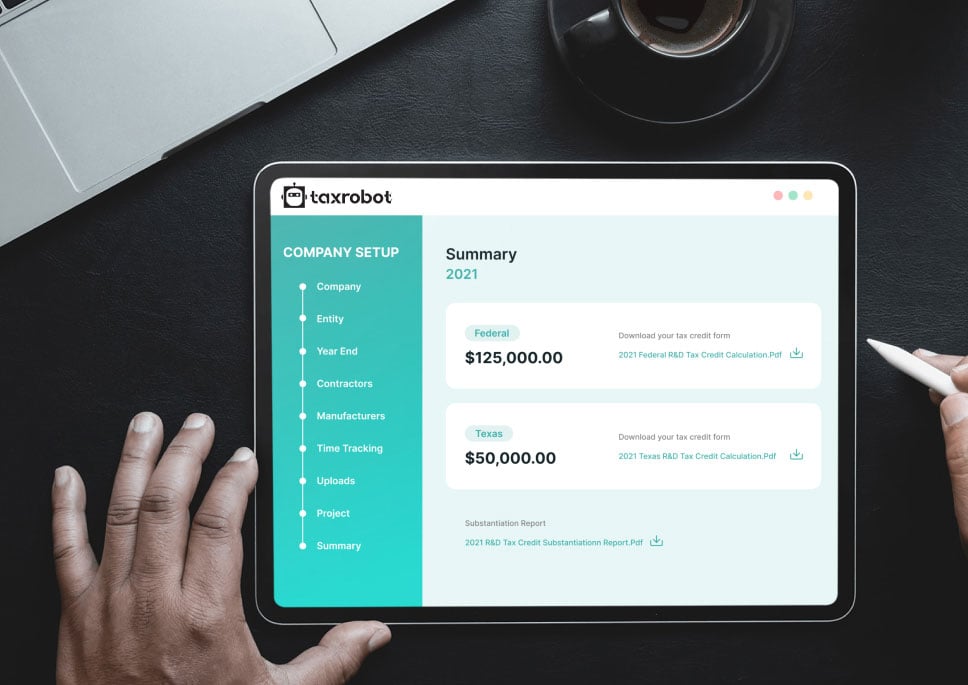Missouri R&D Tax Credit
With TaxRobot, Missouri R&D Tax Credit becomes more than a benefit—it becomes a catalyst for your business growth. Unleashing the incredible, simplifying the complex. This is not just tax planning; it’s financial evolution.
Maximize your State Credits today!
Put the R&D tax credit process on autopilot.
Trusted By:








Missouri R&D Tax Credit
Discover your eligibility for Missouri R&D tax credits and supercharge your enterprise.
Missouri R&D Tax Credit - Boost Your Refunds with TaxRobot
Welcome to the exciting world of Missouri R&D Tax Credits. Businesses have an incredible opportunity to increase their refunds, and TaxRobot is here to simplify the process.
Our AI-powered software is designed to streamline the process, ensuring a hassle-free experience and massive returns. With years of expertise in R&D tax credits, our subject matter experts have delivered millions of dollars to clients nationwide.
So, if you’re ready to unlock larger refunds and simplify your R&D tax credit journey, TaxRobot is here to make it happen.
Understanding the Missouri R&D Tax Credit
The Missouri R&D Tax Credit has recently been reintroduced after a long hiatus, offering a golden opportunity for companies engaged in research and development activities.
With an allocated budget of $10 million, this credit allows businesses to claim 15% of their qualified research expenses. And here’s the exciting part – if your research is conducted in collaboration with a Missouri university, the credit rate can increase to 20%.
This incentive means not only can you receive financial support for your innovative endeavors, but you can also foster partnerships with academic institutions for even greater rewards.
It’s time to leverage the Missouri R&D Tax Credit and accelerate your business growth. Taxrobot is here to guide you every step of the way.
Missouri R&D Tax Credit Eligibility
Determining your eligibility for the Missouri R&D Tax Credit is crucial to take full advantage of this lucrative opportunity.
Your business must engage in qualified research activities that meet the IRS Four-Part Test to qualify, including being technological, serving a permitted purpose, eliminating uncertainty, and involving experimentation.
Additionally, your research expenses must exceed the previous three years’ average to be eligible for the credit.
Collaborating with Missouri universities can further enhance your eligibility and increase the credit rate to 20%.
Maximize Your Refunds With TaxRobot
When it comes to claiming the Missouri R&D Tax Credit, TaxRobot stands out as the ultimate solution. Our cutting-edge software is specifically designed to streamline the process and maximize your refunds.
With TaxRobot, you can count on accurate and efficient calculations that ensure you receive the maximum tax credit possible. Our platform offers a seamless onboarding experience, allowing you to get started quickly and easily.
Plus, our user-friendly interface makes navigating the software a breeze. Say goodbye to complicated paperwork and let TaxRobot simplify your R&D tax credit journey while optimizing your refunds.
Value-Based Pricing and Audit Support
At TaxRobot, we believe in providing value-based pricing to our clients. That means you only pay a fee if you receive a tax credit. We are committed to your success and ensuring you get the most out of your R&D tax credit claim.
In addition, we offer audit support to handle any inquiries or requests that may arise during an audit. With TaxRobot by your side, you can have peace of mind knowing that we have you covered in terms of pricing transparency and support throughout the process.
Comprehensive Documentation and Compliance
TaxRobot takes documentation and compliance seriously to protect your business. We are dedicated to providing superior documentation that satisfies statutory requirements and meets the reporting standards set by the IRS.
Our software is designed to ensure accuracy and compliance, reducing the risk of penalties for your business. With TaxRobot, you can rest assured that your R&D tax credit claim will be supported by comprehensive and compliant documentation, giving you peace of mind throughout the process.
Let us handle the intricate paperwork while you focus on what matters most – driving innovation and growth.
Maximize Your Refunds with TaxRobot for Missouri R&D Tax Credit
When it comes to claiming the Missouri R&D Tax Credit, TaxRobot is your trusted partner. Our AI-powered software simplifies the process, ensuring maximum refunds and minimizing hassle.
With our expertise in R&D tax credits, we deliver superior results, often exceeding what competing consultants and software products offer.
Our dedication to value-based pricing and audit support sets us apart. Trust TaxRobot to provide superior documentation that satisfies statutory and IRS requirements while saving you time and effort.
Unlock the full potential of the Missouri R&D Tax Credit with TaxRobot by your side.
Take a sneak peak

- Limited Time Offer
- Simple Onboarding
- Easy to Use
R&D Tax Credits FAQs
The four-part test as outlined in the Internal Revenue Code is used to determine qualified R&D activity.
The Four-Part Test
1). New Or Improved Business Component
Creation of a new product, process, formula, invention, software, or technique; or improving the performance, functionality, quality, or reliability of existing business component.
- Construction of new buildings or renovation of existing buildings
- Invention of a software application
- Manufacturing of a new product or the improvement of the production process for an existing product
- Creation of design documentation
2). Technological In Nature
The activity fundamentally relies on principles of the physical or biological sciences, engineering, or computer science. A taxpayer does not need to obtain information that exceeds, expands or refines the common knowledge of skilled professionals in a particular field.
- Physics (relationship between mass, density and volume; loading as the
result of gravitational attraction) - Engineering (mechanical, electrical, civil, chemical)
- Computer science (theory of computation and design of computational systems)
3). Elimination Of Uncertainty
Uncertainty exists if the information available to the taxpayer does not establish the capability or method for developing or improving the business component, or the appropriate design of the business component.
- The capability of a manufacturer to create a part within the specified tolerances
- The appropriate method of overcoming unsuitable soil conditions during construction
- The appropriate software design to meet quality and volatility requirements
4). Process Of Experimentation
A process designed to evaluate one or more alternatives to achieve a result where the capability or method of achieving that result, or the appropriate design of that result, is uncertain as of the beginning of the taxpayer’s research activities.
- Systematic process of trial and error
- Evaluating alternative means and methods
- Computer modeling or simulation Prototyping Testing
The R&D tax credit is one of the most misunderstood tax incentives available. Considering the myriad of industries and activities that legally qualify for the credit, the term “research and development” is a misnomer. Additionally, the R&D tax credit requires specialized knowledge and technology to identify and calculate the incentive properly.
Companies of various industries are unaware that they are eligible to claim the R&D tax credit. Under the Internal Revenue Code’s definition of R&D, many common activities qualify. You can get tax benefits for industries including software, technology, architecture, engineering, construction, manufacturing, and more.
The R&D tax credit can be claimed for all open tax years. Generally, open tax years include the prior three tax years due to the statute of limitations period. In certain circumstances, the law allows businesses to claim the R&D tax credit for an extended period of time. It is common for companies to amend previous tax years to claim this benefit and reduce the maximum amount of tax liability.
Partnerships and S corporations must file this form to claim the credit. The credit will flow from the Form 6765, to the Schedule K-1, to the Form 3800 on the individual’s tax return. For individuals receiving this credit that have ownership interest in a partnership or S corporation, Form 6765 is not required on the individual return.
Individuals claiming this credit can report the credit directly on Form 3800, General Business Credit if their only source for the credit is a partnership, S corporation, estate, or trust. Otherwise, Form 6765 must be filed with the individual’s tax return (e.g. sole proprietorship).
For tax years prior to 2016, the credit can be used to reduce the taxpayer’s regular tax liability down to the tentative minimum tax. The credit cannot be used to offset alternative minimum tax. Beginning in tax year 2016, eligible small businesses have expanded utilization for the credit. For these eligible small businesses, the regular tax liability can offset alternative minimum tax using the “25/25” rule.
What our customers have to say
I highly recommend TaxRobot to anyone considering an R&D Tax Credit software to complete their analysis.

We decided to switch to TaxRobot… Best decision we’ve ever made. More affordable, and less complicated.

I couldn’t believe how easy it was! In under an hour, we saved enough money to hire a new employee.
